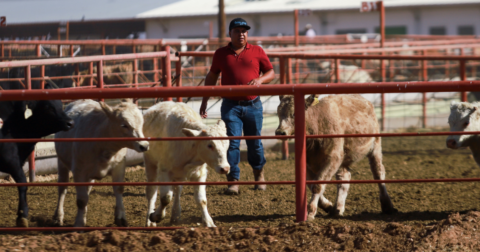News
Senate Finally OKs Plant-Based Milk in Public Schools
Policy•5 min read
News
“It's hard to get ahead of it, because the animals can't talk to us and tell us they have a problem.”


Words by Seth Millstein
On May 11, Secretary of Agriculture Brooke Rollins announced that the U.S. is suspending all livestock imports from Mexico due to a resurgence of New World screwworm. Mexican authorities detected the parasitic fly, which was ostensibly eradicated decades ago, in southern Mexico earlier in the month after an outbreak in Panama years ago. Now, officials are increasingly concerned that the screwworm could reach the U.S., and wreak havoc on American farm animals.
Rollins says that the suspension will apply to live cattle, bison and horses, and will be renewed “on a month-by-month basis, until a significant window of containment is achieved.” In the meantime, U.S. officials and cattle farmers are on edge.
“It is very, very bad, and it’s not just cattle,” Dr. Rod Hall, the state veterinarian for Oklahoma, tells Sentient. “The screwworms can affect any warm-blooded animal, so it would be devastating to any of our livestock species.”
The New World screwworm isn’t a worm at all, but a parasitic fly whose larvae infest and burrow into the tissue of warm-blooded animals. Female screwworms are attracted to open wounds, and bodily orifices in general, and that’s often where they lay their eggs. Once the larvae hatch, they burrow into the host creatures’ tissue with their powerful mouth hooks.
While several fly species are attracted to open wounds, screwworms are unique in that they infest healthy, living tissue, as opposed to the flesh of dead creatures. What’s more, screwworms can lay up to 400 eggs at once, so even a single pregnant fly is bad news for any warm-blooded creature unfortunate enough to encounter one.
“When they get to a certain point, they fall out, burrow into the ground for a week or so, and then they turn into more flies,” Hall explains. “So oftentimes, by the time a human realizes that an animal is infected, the damage has already been done, and the next generation [of screwworms] is in the soil, waiting to turn into adult flies so they can lay more eggs.”
Myiasis is the official term for a screwworm infestation of living tissue, and it can kill the host creature in one to two weeks if not treated. Thankfully, myiasis is survivable if treated with larvicides, insecticides and daily cleaning of the wounds — that is, if it’s detected in time, which is often the biggest challenge for livestock farmers.
Screwworm is a health threat to animals and an economic threat to meat industry producers. But it’s generally not considered a public health risk to humans.
Public health officials have said that any livestock infected by the screwworm wouldn’t make its way into the domestic meat supply, due to federal meat inspection laws. And although the parasite can infect humans, anybody with such an infection “would notice something” was wrong in time to treat it, Todd Thrift, associate professor of animal sciences at the University of Florida, tells Sentient.
“Unless it was someone that was just totally unaware, this is not something that rapidly affects people,” Thrift says. “The probability of it being a human health threat is very, very, very, very low.”
As its name implies, the New World screwworm only exists in the Western hemisphere; there’s also an Old World screwworm, which is found in parts of Africa, Asia, the Middle East and Oceania. Both types of screwworms live in tropical and subtropical climates, and can’t survive extreme heat or cold.
New World screwworms are endemic in South America, Cuba, Haiti and the Dominican Republic, but usually aren’t found north of Panama. There are no screwworms in the U.S. — but there used to be, and it’s taken quite a bit of effort to keep them out.
Until the 1960s, the New World screwworm was common across Mexico and the southern United States. After its initial detection off the coast of Guiana in 1858, the parasite became a major problem in North America around the turn of the century as America’s livestock industry became more developed and expansive.
By 1920, the screwworm was a serious enough issue on U.S. farms that the Department of Agriculture produced an informational video on how to stop them. But the species was still poorly understood at this point, and it wasn’t until the 1930s that a series of discoveries about the screwworm equipped scientists to begin developing a plan for eradicating them.
The key was sterilization. Female screwworms only mate once in their lives, so scientists developed a way of sterilizing male screwworms without otherwise harming them, then released the sterile males en masse into screwworm populations. This became known as the Sterile Insect Technique, and it worked: By 1966, New World screwworm was fully eradicated in the U.S., and remaining populations in Mexico were successfully eliminated by 1991.
Ensuring that the U.S. remains screwworm-free, however, has been an ongoing and international effort. Because an adult screwworm can travel up to 125 miles before laying eggs, eradicating the species in the U.S. effectively requires that Mexico be free of the fly as well. The U.S. and Panama maintain a buffer zone of sterilized flies in eastern Panama to prevent the screwworm from migrating northward, and several other international collaborations have helped keep the species’ populations in check — for the most part.
Although the U.S.-Panamanian buffer zone has largely been a success, it’s not completely impermeable. There have been isolated outbreaks of the screwworm in the U.S. at various points since 1966, most recently in the Florida Keys in 2016, but all were eventually contained.
In 2023, however, a major screwworm outbreak occurred in Panama; though it’s not entirely clear how the screwworm managed to escape the buffer zone, conservationists have suggested that illegal cattle trafficking is to blame. Since then, the fly has been detected in several countries north of the buffer zone, including Costa Rica, Nicaragua, Honduras, Guatemala, Belize and El Salvador.
“Panama was pretty much focusing all the sterile male flies in the Panama region to control it there,” Hall says. “So once it got out of the control area without people knowing it, it had the opportunity to begin spreading. And it’s hard to get ahead of it, because the animals can’t talk to us and tell us they have a problem.”
This is a big reason screwworm is so hard to combat: the lag time between infection and detection. It’s why screwworms are a much bigger problem on cattle farms, where cows are often dispersed over a large area and aren’t seen for days at a time, than on pig farms, where animals tend to be confined in tight quarters, and farmers can typically put eyes on each animal every day.
“It might be a few weeks before the authorities [in Central America] would realize that they had a case of it,” Hall says. “And by then, the screwworm flies had multiplied and moved even further. So instead of being able to get ahead of it, we’re kind of chasing it.”
In 2024, a New World screwworm infected a cow in southern Mexico near the border of Guatemala. In response, the USDA suspended livestock imports to the U.S. from Mexico in November 2024, and increased its deployments of sterile screwworm males south of the border. By February 2025, the U.S. and Mexico had agreed to a series of enhanced security protocols aimed at preventing screwworm from crossing the U.S.-Mexican border, and the suspension was lifted.
In May, however, the USDA announced that screwworms had been detected in Mexican farms around 700 miles from the U.S. border. It was this discovery that compelled Rollins to suspend Mexican livestock imports again.
In her announcement, Rollins stressed that the import suspension “is not about politics or punishment of Mexico, [but] about food and animal safety.” Nevertheless, there has been a bit of political tension between the U.S. and Mexico as of late that’s worth noting.
Some of this tension has been strictly rhetorical; Mexican President Claudia Scheinbaum didn’t take kindly to President Trump’s suggestion that the Gulf of Mexico be renamed the “Gulf of America,” for instance. But some has been more substantive, stemming from Trump’s new tariffs on Mexico and his visa suspensions of certain Mexican officials.
In April, Rollins accused the Mexican government of delaying U.S. efforts to contain screwworms in Panama, and demanded that it “eliminate restrictions on USDA aircraft and waive customs duties on eradication equipment.”
The two countries quickly struck a deal to resolve this issue, but the new import suspension has frustrated Mexican authorities, with Scheinbaum calling it “unfair” and defending her government’s efforts to fight the parasite.
The presence of screwworms is panic-inducing for many American farmers. But in many parts of South America, they’re just the cost of doing business.
“In South America, they live with this,” Thrift says. “It’s there all the time, and so it doesn’t wipe out their cattle populations or the wildlife populations or anything else. It’s just part of the normal flora.”
This begs the question of how these countries deal with the screwworm. The answer is decidedly low-tech, according to Thrift: They just check the cattle for infections more frequently.
“Beef production in some of the South American countries is different because their labor is considerably cheaper,” says Thrift. “Having 20 cowboys out there checking for this pest, and doctoring any animals that might have it, would not be near the labor burden that it would be in this country.”
For his part, Thrift isn’t quite as apocalyptic as some others about the prospect of screwworms returning to the U.S. He notes that the detections in Mexico are “still 700 miles from the [U.S.] border,” and that although the parasite would cause problems for cattle ranchers, the screwworm itself “is not an unsolvable problem.”
“There’s definitely concern,” he says, “but this is not something that is insurmountable.”